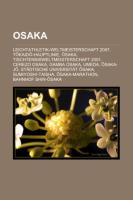| Artikelnummer | 9781159237363 |
|---|---|
| Produkttyp | Buch |
| Preis | 40,90 CHF |
| Verfügbarkeit | Lieferbar |
| Einband | Kartonierter Einband (Kt) |
| Meldetext | Folgt in ca. 5 Arbeitstagen |
| Autor | Books LLC |
| Verlag | Books LLC, Reference Series |
| Weight | 0,0 |
| Erscheinungsjahr | 20150119 |
| Seitenangabe | 128 |
| Sprache | ger |
| Anzahl der Bewertungen | 0 |
Osaka Buchkatalog
Quelle: Wikipedia. Seiten: 127. Nicht dargestellt. Kapitel: Leichtathletik-Weltmeisterschaft 2007, Tokaido-Hauptlinie, Osaka, Tischtennisweltmeisterschaft 2001, Cerezo Osaka, Gamba Osaka, Umeda, Osaka-Jo, Städtische Universität Osaka, Sumiyoshi-Taisha, Osaka-Marathon, Bahnhof Shin-Osaka, Hollywood Dream: the Ride, Technische Hochschule Osaka, Osaka Tenman-Gu, Osaka Dome, U-Bahn Osaka, Wirtschaftsuniversität Osaka, Bahnhof Osaka, Funai Electric, Nagai Stadium, Wta Osaka, Dainembutsu-Ji, Tsutenkaku, Orix Buffaloes, Kaiyukan, Obergericht Osaka, Kamagasaki, Osaka Abc Tower. Auszug: Osaka Osaka) ·) is a city in the Kansai region of Japan's main island of Honshu, the designated city under the Local Autonomy Law, the capital city of Osaka Prefecture and also the heart of Greater Osaka Area. Located at the mouth of the Yodo River on Osaka Bay. Osaka is the third largest city by population after Tokyo and Yokohama. For reference, Greater Osaka Area is the second largest area in Japan by population and one of largest metropolitan areas highly ranked in the world, with nearly 18 million people, and by GDP, the second largest area in Japan and the seventh largest area in the world. Historically the commercial capital of Japan, Osaka functions as one of the command centers for the Japanese economy. The ratio between daytime and night time population is 141%, the highest in Japan, highlighting its status as an economic center. Its nighttime population is 2.6 million, the third in the country, but in daytime the population surges to 3.7 million, second only after Tokyo. Osaka has traditionally been referred to as the "nation's kitchen" tenka no daidokoro), or the Mecca of gourmet food. Some of the earliest signs of habitation in the area of Osaka were found at the Morinomiya remains Morinomiya iseki), with its shell mounds, including sea oysters and buried human skeletons from the 5th-6th centuries BC. It is believed that what is today the Uehonmachi area consisted of a peninsular land, with an inland sea in the east. During the Yayoi period, permanent habitation on the plains grew as rice farming became popular. By the Kofun period, Osaka developed into a hub port connecting the region to the western part of Japan. The large numbers, and the increasing size, of tomb mounds found in the plains of Osaka are seen as evidence of political-power concentration, leading to the formation of a state. In 645, Emperor Kotoku built his palace, the Naniwa Nagara-Toyosaki Palace in Osaka, making this area the capital (Naniwa-kyo). The place that became the modern cit
40,90 CHF
Lieferbar


Dieser Artikel hat noch keine Bewertungen.